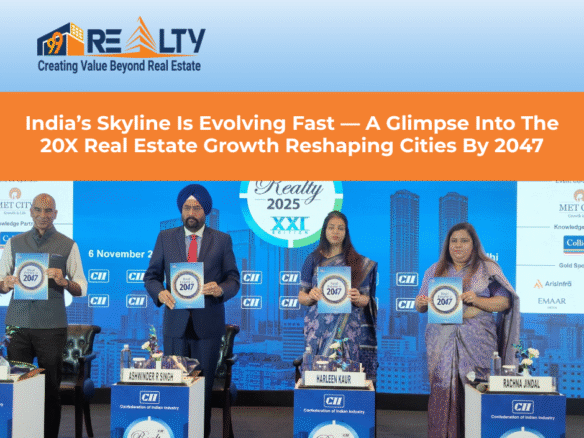In 2024, India’s real estate sector experienced significant developments across various dimensions, including regulatory changes, market dynamics, technological advancements, and investment trends. 99Realty have covered most of these topics in our regular articles and this comprehensive article brings to you the major events in the Indian Real Estate Sector in 2024 along with our future prospective for the year ahead.
Regulatory Developments
- Property Tax Reforms: In August 2024, India’s lower house of parliament approved revisions to property tax rules following public backlash. Taxpayers were given the option to choose between a 12.5% rate without inflation adjustment or the previous 20% rate with it, aiming to provide flexibility and relief, especially for those selling older properties. Relief for Property Owners: Government Amends Indexation Proposal for Real Estate Taxation
- Incentives for Job Creation: The 2024/25 budget, presented in July 2024, announced a $24 billion expenditure over five years to create jobs and enhance rural development. This budget emphasized infrastructure, agriculture, and skilling, with initiatives like climate-resistant seed varieties and digital infrastructure, indirectly benefiting the real estate sector by boosting economic growth and consumption. India’s Real Estate Industry: The Next Employment Generation Hub
Also Read: Budget 2024: Comprehensive Analysis of New Rules Impacting Homebuyers, Property Investors, and Developers and Budget 2024: Analyzing the Impact on Urban Housing and Real Estate
Market Demand and Supply Dynamics
- Luxury Housing Surge: Home prices in India saw a steady rise, driven by increased demand for luxury properties among wealthy individuals. Prices, which rose by 4.3% in the previous year, were projected to increase by 7.75% in 2024, with expectations of a 6.0%-6.25% rise over the next two years. This trend highlighted a growing preference for high-end real estate investments. (Source: Reuters) The Surge in India’s Luxury Residential Market: An In-Depth Analysis
- Affordable Housing Challenges: Despite the growth in luxury housing, challenges persisted in the affordable housing segment. Urban oversupply led to pricing challenges in saturated markets, while suburban areas, especially tier-2 cities, witnessed rising demand due to infrastructure development. The need to redefine affordable housing and expand benefits was emphasized to propel growth in this segment. Understanding the Impact of the Reintroduced Interest Subsidy Under PMAY in Budget 2024
- Commercial Sector: Grade A office space uptake across major cities reached new heights, driven by demand from sectors such as BFSI, engineering, manufacturing, and healthcare.
Also Read: The Rise of Elegance: Exploring Affordable Luxury in Indian Real Estate and The Rise of Affordable Housing: Opportunities and Challenges in India
Technological Integration
- PropTech Innovations: The real estate sector embraced technologies like Virtual Reality (VR) for immersive property tours, Artificial Intelligence (AI) for predictive analytics and personalized customer experiences, and Blockchain for enhancing transparency and security in transactions. These advancements redefined the real estate experience for investors, developers, and homebuyers. Top Technology Trends Revolutionizing Real Estate in 2024
- Smart Housing Projects: There was a rise in smart housing projects tailored to tech-savvy buyers, with developers integrating cutting-edge amenities that appealed to high-net-worth individuals.
- Sustainable Practices: The demand for sustainable housing in the luxury segment gained momentum, reflecting a growing awareness of eco-friendly living practices. Mivan Construction Technology: Revolutionizing Modern Construction
Investment Trends
- Foreign Investments: Equity capital inflows reached $8.9 billion, indicating continued growth across sectors, including industrial and logistics. (Source: Economic Times)
- Tier 2 City Growth: Investments in Tier 2 cities increased, driven by infrastructure advancements and rising buyer aspirations.
Major Milestones in 2024
- Introduction of Real Estate Investment Trusts (REITs): REITs gained prominence, offering accessible, liquid, and regulated investment options. They provided benefits like regular income, portfolio diversification, and professional management, contributing to the sector’s growth and transparency. The Ultimate Guide to Real Estate Investment Trusts (REITs)
- Sustained Growth in Transaction Volumes: Commercial real estate transaction volumes reached an annual level of close to €10 billion in early 2024, indicating a gradual rise over the past decade and reflecting increased investor confidence. (Source: DWS)
- Record Office Leases: The office sector excelled with 53.3 million sq. ft leased, reflecting strong demand in key cities like Bengaluru, Hyderabad, and Pune.
- Luxury Housing Boom: The luxury housing market experienced a boom during the first nine months of 2024, with sales of high-end residential units increasing significantly.
- India’s Advancement to a Transparent Real Estate Market: India’s elevation to the transparent tier in the GRETI 2024 is a historic achievement, signifying a paradigm shift in the country’s real estate market. For the first time, India’s Tier 1 markets have been recognized as transparent, earning the 31st rank globally with a composite score of 2.44. India’s Advancement to a Transparent Real Estate Market in 2024: A Comprehensive Analysis
- Policy Support and Investor Confidence: The sector thrived on policy support and heightened investor confidence, with demand observed across various asset classes, setting the stage for continued growth into 2025.
- Technological Advancements: Developers focused on integrating modern amenities and technology into projects, catering to evolving work and lifestyle needs.
Also Read: Real Estate Growth in Tier II and III Cities of India: A Game Changer for 2024
Indian Real Estate Market Outlook for 2025
The Indian real estate sector is poised for significant developments in 2025, with projections indicating a steady increase in property prices, particularly in the luxury segment. This trend is largely driven by demand from affluent buyers, even as challenges persist in the affordable housing sector.
Projected Increase in Property Prices: Recent analyses suggest that home prices in India are expected to rise by approximately 6.5% in 2025, following a 7% increase in 2024. This upward trajectory is primarily attributed to the purchasing power of the wealthy, who continue to invest in luxury properties despite broader economic challenges. (Source: Reuters)
Demand Dynamics in the Luxury Housing Segment: The luxury housing market has experienced a notable surge, with its share of total sales increasing from 15-16% before the pandemic to about 28% in recent years. This growth is expected to persist into 2025, driven by high-net-worth individuals seeking premium properties in urban centers. (Source: Reuters) The demand for luxury housing is expected to persist, particularly in metro cities, while Tier 2 cities are becoming increasingly attractive for luxury and high-end buyers.
Challenges in Affordable Housing: Despite the overall growth in the real estate market, the supply of affordable housing continues to lag behind demand. High mortgage rates and limited availability of budget-friendly homes pose significant obstacles for first-time buyers. Experts anticipate that this mismatch between supply and demand in the affordable segment will persist over the next few years.
Regional Variations in Property Prices: Property price trends are expected to vary across different regions. Major cities like Delhi-NCR have already witnessed substantial increases; for instance, average residential prices in Delhi-NCR rose from ₹5,800 per sq. ft. in 2023 to nearly ₹7,550 per sq. ft. in 2024, marking a 30% increase. While such sharp rises may not continue uniformly across all regions, key areas near commercial hubs and select peripheral locations are projected to experience notable price escalations in 2025.
Consolidation and Innovation: The market is expected to undergo consolidation, with a focus on innovation and sectoral diversification.
Emerging Asset Classes: Alternative asset classes like data centers, co-living arrangements, and senior housing are positioned for rapid growth, fueled by changing demographics and evolving consumer preferences.
Conclusion
The Indian real estate market in 2025 is set to continue its growth trajectory, with significant contributions from the luxury housing segment. However, addressing the persistent challenges in affordable housing remains crucial to ensure inclusive growth in the sector.
Looking ahead, the Indian real estate market is poised for continued growth in both residential and commercial sectors. Factors such as urban migration, increasing wealth concentration, and the entry of a growing young population into the housing market are expected to drive moderate price appreciation. Key areas near commercial hubs in major cities are anticipated to see sharper price increases.
Additionally, the sector is expected to witness a transformation with a focus on affordable housing and strategic land investments, particularly in emerging cities. Investors are advised to consider opportunities in tier-2 cities, driven by infrastructure development, and to stay informed about evolving trends and policy impacts to make sound investment decisions.
Investors should monitor these trends and consider the evolving regulatory landscape, technological integration, and shifting market demands when making investment decisions in 2025.
Subscribe to get updates on our latest posts and market trends.






Join The Discussion